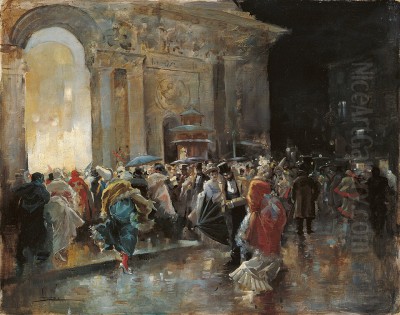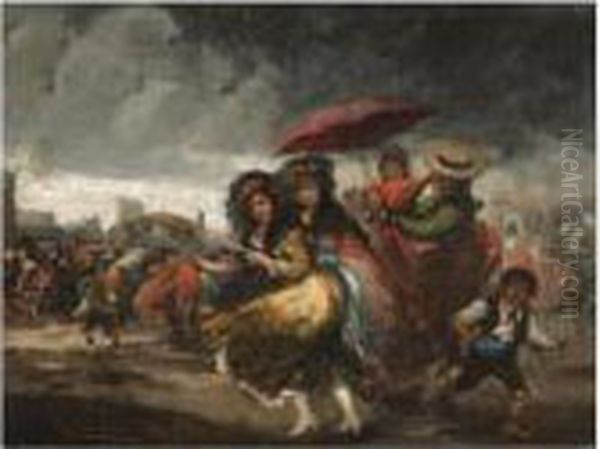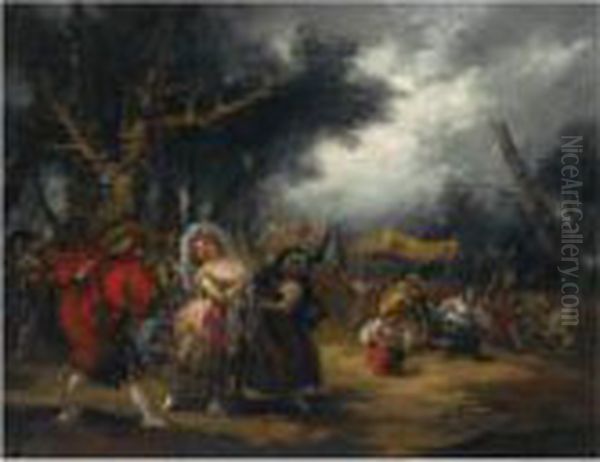
Eugenio Lucas Villamil stands as a fascinating figure in late nineteenth and early twentieth-century Spanish art. Born in Madrid in 1858 and passing away in the same city in 1918, his artistic journey was deeply intertwined with the towering legacies of his own father, the painter Eugenio Lucas Velázquez, and the ultimate Spanish master, Francisco Goya. Villamil dedicated much of his career to exploring, imitating, and reinterpreting the styles and themes pioneered by these predecessors, carving out a distinct, albeit often overshadowed, niche for himself within the rich tapestry of Spanish painting during a period of significant artistic transition. His work, characterized by a vigorous technique and a focus on traditional Spanish subjects, offers valuable insights into the enduring power of Goya's vision and the complexities of artistic inheritance.
Early Life and Paternal Influence
Eugenio Lucas Villamil entered the world in Madrid, the son of Eugenio Lucas Velázquez (1817-1870), a prominent painter already renowned for his Goya-inspired works. The elder Lucas Velázquez was a significant figure in Spanish Romanticism, celebrated for his dynamic compositions, dramatic lighting, and themes drawn from Spanish folklore, history, and Goya's own repertoire. Growing up in such an environment meant that the young Villamil was immersed in art from his earliest years. He inevitably absorbed his father's techniques and thematic preoccupations.
Tragically, Eugenio Lucas Velázquez died when his son was only twelve years old. This early loss profoundly shaped Villamil's path. Lacking his father's direct guidance during his formative teenage years, Villamil turned even more intensely to his father's artistic example. He began to meticulously study and emulate his father's style, which itself was a filter through which the influence of Goya passed. This act of imitation became a cornerstone of Villamil's early development and a defining characteristic of his entire career. He essentially learned to paint by walking in his father's footsteps, inheriting not just a style but a specific artistic lineage heavily indebted to Goya.

This paternal influence was both a blessing and a burden. It provided Villamil with a ready-made artistic language and a connection to the celebrated tradition of Spanish Romanticism. However, it also made it challenging for him to establish a fully independent artistic identity. His close adherence to his father's mannerisms contributed significantly to the later confusion surrounding the attribution of works between the two artists.
The Shadow of Goya
The influence of Francisco Goya y Lucientes (1746-1828) on Spanish art is immeasurable, and his shadow looms particularly large over the careers of both Eugenio Lucas Velázquez and his son, Eugenio Lucas Villamil. Goya's revolutionary approach to painting, his unflinching social commentary, his exploration of the darker aspects of human nature, and his technical innovations left an indelible mark. For artists like the Lucases, working in the generations after Goya, engaging with his legacy was almost unavoidable, especially for those drawn to Romantic themes and expressive techniques.
Villamil, following his father's lead, actively engaged with Goya's oeuvre. This wasn't merely a passive influence; it involved direct imitation and the creation of pastiches in Goya's style. He copied specific compositions and adopted Goya's characteristic subject matter: dramatic bullfights, scenes of majas and majos (figures from Madrid's lower classes known for their distinctive dress and manners), religious scenes imbued with intense emotion, and depictions of witchcraft or the supernatural that echoed Goya's famous Caprichos and Black Paintings.
Villamil absorbed Goya's technical freedom, particularly the use of expressive brushwork, dramatic chiaroscuro (contrasts of light and dark), and a sometimes somber palette punctuated by flashes of color. He sought to capture the energy, the psychological depth, and the uniquely Spanish atmosphere that permeated Goya's work. While he may not have reached Goya's level of profound innovation or psychological insight, Villamil's dedication to the Goyaesque style ensured its continued visibility and relevance in Spanish art well into the late nineteenth century. His work serves as a testament to the enduring power and adaptability of Goya's artistic vision.
Artistic Style and Technique
Eugenio Lucas Villamil developed a distinctive, albeit derivative, artistic style characterized by its energy and freedom. Building upon the foundations laid by his father and Goya, his technique emphasized expressive brushwork and a dynamic approach to composition. His paintings often feature short, thick, and vigorous brushstrokes, applied with a sense of immediacy and spontaneity. This technique, sometimes described as impetuous, lent his works a lively surface texture and a sense of movement.

He employed impasto, the technique of applying paint thickly so that brushstrokes are visible, to build up forms and create highlights. This contrasts with the smoother, more blended finish favored by academic painters of the era. Villamil's handling of light and shadow was often dramatic, echoing the chiaroscuro of Goya and the Baroque masters, which helped to create mood and focus attention within the composition. His color palette could range from the somber tones associated with Goya's later works to brighter, more vibrant hues, depending on the subject matter.
While skilled, particularly as a draftsman, Villamil's technique is often considered less refined than that of his father. Critics sometimes point to a certain simplification in his rendering of figures and a less meticulous approach to detail. However, this perceived lack of finesse can also be interpreted as a deliberate choice, prioritizing overall effect, energy, and emotional impact over precise representation. His style was well-suited to capturing the dynamism of crowds, the swirling motion of a bullfight, or the ruggedness of a landscape. It was a style rooted in Romantic expressiveness rather than academic polish.
Key Themes and Representative Works
The subject matter explored by Eugenio Lucas Villamil reflects his deep engagement with Spanish traditions and the Goyaesque legacy. He frequently returned to themes that were popular within Spanish Romanticism and had strong ties to national identity. Scenes of bullfighting were a recurring motif, allowing him to explore drama, movement, and popular Spanish culture. A notable example is The Bullfight, now housed in the National Gallery of Art in Washington D.C., which captures the chaotic energy and spectacle of the corrida.
Villamil also excelled in costumbrista painting, depicting scenes of everyday life, local customs, and regional types. These works often featured majas and majos, bandits, smugglers, and peasants, continuing a tradition popularized by Goya and embraced by Romantic artists seeking authentic national character. His Landscape with Smugglers exemplifies this interest, portraying figures within a rugged Aragonese landscape, reflecting both the picturesque appeal of such scenes and contemporary perceptions of Spain's diverse regions.
Religious subjects also appeared in his work, often treated with the dramatic intensity characteristic of the Spanish Baroque and Goya's religious paintings. Furthermore, allegorical themes played a significant role, particularly in his commissioned works. For his patron, José Lázaro Galdiano, he executed important decorative cycles, including murals like Allegory of Patronage, Charity and Love and Flora, which adorned the ceilings of Galdiano's Madrid palace (now the Museo Lázaro Galdiano). These works demonstrate his ability to handle large-scale compositions and adapt his style to allegorical representation, blending traditional iconography with his characteristic Goya-inspired technique.
Patronage and Professional Life
Eugenio Lucas Villamil navigated his artistic career primarily within the cultural milieu of Madrid. Unlike some of his contemporaries who sought fame and fortune abroad, Villamil remained rooted in the Spanish capital, living a relatively modest life and earning his living through his painting. His connections within Madrid's intellectual and artistic circles were important, but his career was particularly shaped by the support of a key patron: the influential collector and financier José Lázaro Galdiano (1862-1947).
Lázaro Galdiano was one of Spain's most important art collectors and cultural figures at the turn of the century. His decision to commission Villamil to create decorative murals for his opulent residence, the Parque Florido palace in Madrid, was a significant endorsement of the artist's talent and a crucial source of income and prestige. These commissions, including the aforementioned allegorical ceilings, allowed Villamil to work on a grand scale and ensured his art would be seen in one of Madrid's most important private collections, which later became the public Museo Lázaro Galdiano.
This patronage highlights the continuing importance of private support for artists in this period, even as public exhibitions and state commissions grew. For an artist like Villamil, whose style might not have always aligned with official academic tastes, the backing of a discerning collector like Lázaro Galdiano was invaluable. It provided him with opportunities to create ambitious works and solidified his position within the Madrid art scene, linking his name permanently with one of Spain's most significant cultural institutions.
The Challenge of Attribution
One of the most persistent issues surrounding Eugenio Lucas Villamil is the difficulty in definitively attributing works among him, his father Eugenio Lucas Velázquez, and even Francisco Goya himself. This confusion stems from several factors. Firstly, Villamil deliberately and skillfully imitated the styles of both his father and Goya throughout his career. His technical approach, thematic choices, and compositional strategies often closely mirrored those of his predecessors.
Secondly, his father, Eugenio Lucas Velázquez, was also a prolific producer of Goya-inspired works, creating a complex web of stylistic similarities. Distinguishing between the father's Goya interpretations and the son's interpretations of both Goya and his father can be exceptionally challenging for art historians and connoisseurs. Signatures can be unreliable or absent, and the sheer volume of Goyaesque paintings produced by both artists complicates matters further.
This ambiguity has led to ongoing debates and reattributions over the years. Works once confidently assigned to Goya have sometimes been reassigned to Lucas Velázquez, and differentiating between the father and son remains a specialized field of study. Specific paintings, such as a work sometimes referred to as The Bulldog, have been subject to shifting attributions, highlighting the uncertainty that clouds Villamil's oeuvre. While this confusion underscores Villamil's skill as an imitator, it has also arguably hindered the full appreciation of his individual artistic contributions, forever tying his reputation to the question of authenticity and influence.
Place within Spanish Art History
Eugenio Lucas Villamil occupies a specific and significant place within the narrative of Spanish art history, primarily as a late exponent of the Romantic tradition heavily influenced by Goya. Working in the latter half of the nineteenth century and into the early twentieth, he operated during a time when Spanish art was diversifying, with the rise of Realism, the influence of Impressionism, and the emergence of Modernisme, particularly in Catalonia. Yet, Villamil largely remained committed to the Goyaesque aesthetic inherited from his father.
He belongs firmly within the Spanish Romantic movement, which lingered longer in Spain than in some other European countries. This movement emphasized emotion, individualism, historical nostalgia, and an interest in national folklore and customs – all elements present in Villamil's work. His focus on bullfights, costumbrista scenes, and dramatic landscapes aligns perfectly with Romantic sensibilities. His expressive technique, prioritizing energy and effect over academic finish, further solidifies this connection.
While not an innovator on the scale of Goya, or even contemporaries who were exploring new artistic directions like Joaquín Sorolla or Ignacio Zuloaga, Villamil played a crucial role in perpetuating a specific, potent strain of Spanish artistic identity. He kept the Goya tradition alive and visible at a time when other styles were gaining prominence. His work serves as a bridge, linking the high Romanticism of the early-to-mid nineteenth century (represented by his father and artists like Jenaro Pérez Villaamil) to the turn of the century, demonstrating the enduring appeal of Goya's themes and techniques for successive generations.
Contemporaries and Influence
Eugenio Lucas Villamil worked during a vibrant period in Spanish art, alongside artists exploring a wide range of styles. While he remained focused on the Goyaesque tradition, the broader artistic landscape included major figures charting different courses. Joaquín Sorolla (1863-1923), a near-contemporary, became internationally famous for his luminous, Impressionist-influenced beach scenes and portraits, representing a brighter, more optimistic vision of Spain. Ignacio Zuloaga (1870-1945), though also deeply interested in Spanish tradition and influenced by Goya and El Greco, developed a darker, more severe style often focused on Basque culture and stark portraiture.
Other contemporaries included Mariano Fortuny (1838-1874), whose detailed, brilliantly colored genre scenes had been highly influential earlier; the landscape painters Aureliano de Beruete (1845-1912), associated with a form of Spanish Impressionism, and Darío de Regoyos (1857-1913), who experimented with Pointillism. In Catalonia, figures like Santiago Rusiñol (1861-1931) and Ramón Casas (1866-1932) were key proponents of Modernisme (Art Nouveau). Compared to these diverse trends, Villamil's adherence to the style of his father and Goya appears conservative, yet it represented a valid and persistent artistic current.
Villamil's direct circle included artists mentioned in historical sources, such as Villanueva and Antonio Pérez Rubio, who likely shared similar artistic inclinations. Importantly, Villamil himself exerted influence on subsequent artists who continued the Goyaesque tradition or were inspired by his costumbrista themes. Painters like Ángel Lizcano Monedero (1846-1929), known for his historical and genre scenes, show affinities with the Lucas school. Villamil's primary influence, therefore, lies in his role as a conduit, transmitting the stylistic and thematic concerns of his father and Goya to a later generation, ensuring the continuation of this particular lineage within Spanish art.
Legacy and Collections
The legacy of Eugenio Lucas Villamil is complex, shaped by his talent, his chosen artistic path, and the persistent issue of attribution. He is remembered primarily as a skillful follower and interpreter of Eugenio Lucas Velázquez and Francisco Goya, rather than as a major innovator. However, his dedication to this tradition provides valuable insight into the enduring power of Goya's influence on Spanish art and culture. His works capture a particular vision of Spain – dramatic, traditional, and imbued with Romantic sentiment – that continued to resonate even as modernism began to take hold.
His association with the major collector José Lázaro Galdiano ensured that a significant body of his work, particularly his large-scale decorative paintings, is preserved in the Museo Lázaro Galdiano in Madrid. This institution remains the most important repository of his art and a key center for the study of his life and work. Beyond the Lázaro Galdiano, Villamil's paintings can be found in other significant collections, demonstrating his recognition within the Spanish art establishment of his time and beyond.
Works by Eugenio Lucas Villamil are held by the Museo Nacional del Prado in Madrid (which also holds works by his father, facilitating comparison), the National Gallery of Art in Washington D.C., and the Museu Nacional d'Art de Catalunya (MNAC) in Barcelona, among others. The presence of his art in these major museums confirms his status as a recognized figure in Spanish art history, appreciated for his technical skill, his energetic style, and his role in carrying forward the Goyaesque tradition into the early twentieth century.
Conclusion
Eugenio Lucas Villamil remains a compelling, if sometimes enigmatic, figure in the history of Spanish art. Born into the shadow of a famous artistic father and the even longer shadow of Francisco Goya, he dedicated his career to navigating this powerful inheritance. His paintings, characterized by vigorous brushwork, dramatic themes, and a deep engagement with Spanish popular culture and the Goyaesque aesthetic, offer a unique window onto the artistic currents of late nineteenth-century Spain. While often grappling with issues of attribution and the perception of being primarily an imitator, Villamil's skill and artistic personality are undeniable. Through his prolific output and his significant commissions, particularly for José Lázaro Galdiano, he carved out a lasting place for himself, ensuring that the expressive power and thematic richness of the Romantic tradition, filtered through the lens of Goya, continued to resonate well into the modern era. His work stands as a testament to the complexities of artistic influence and the enduring dialogue between generations of artists.